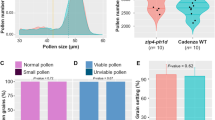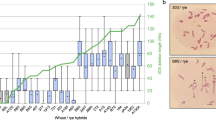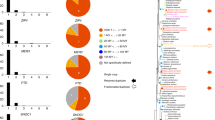Abstract
The foundation of western civilization owes much to the high fertility of bread wheat, which results from the stability of its polyploid genome. Despite possessing multiple sets of related chromosomes, hexaploid (bread) and tetraploid (pasta) wheat both behave as diploids at meiosis. Correct pairing of homologous chromosomes is controlled by the Ph1 locus1. In wheat hybrids, Ph1 prevents pairing between related chromosomes2. Lack of Ph1 activity in diploid relatives of wheat suggests that Ph1 arose on polyploidization3. Absence of phenotypic variation, apart from dosage effects, and the failure of ethylmethane sulphonate treatment to yield mutants, indicates that Ph1 has a complex structure4,5. Here we have localized Ph1 to a 2.5-megabase interstitial region of wheat chromosome 5B containing a structure consisting of a segment of subtelomeric heterochromatin that inserted into a cluster of cdc2-related genes after polyploidization. The correlation of the presence of this structure with Ph1 activity in related species, and the involvement of heterochromatin with Ph1 (ref. 6) and cdc2 genes with meiosis, makes the structure a good candidate for the Ph1 locus.
This is a preview of subscription content, access via your institution
Access options
Subscribe to this journal
Receive 51 print issues and online access
$199.00 per year
only $3.90 per issue
Buy this article
- Purchase on Springer Link
- Instant access to full article PDF
Prices may be subject to local taxes which are calculated during checkout

Similar content being viewed by others
References
Riley, R. & Chapman, V. Genetic control of cytologically diploid behaviour of hexaploid wheat. Nature 182, 713–715 (1958)
Riley, R., Chapman, V. & Kimber, G. Genetic control of chromosome pairing in intergeneric hybrids with wheat. Nature 183, 1244–1246 (1959)
Chapman, V. & Riley, R. Homoeologous meiotic chromosome pairing in Triticum aestivum in which chromosome 5B is replaced by an alien homoeologue. Nature 226, 376–377 (1970)
Wall, A. M., Riley, R. & Gale, M. D. The position of a locus on chromosome 5B of Triticum aestivum affecting homoeologous meiotic pairing. Genet. Res. Camb. 18, 329–339 (1971)
Martinez, M., Naranjo, T., Cuadrado, C. & Romero, C. The synaptic behaviour of Triticum turgidum with variable doses of the Ph1 locus. Theor. Appl. Genet. 102, 751–758 (2001)
Dover, G. A. & Riley, R. Prevention of pairing of homoeologous meiotic chromosomes of wheat by an activity of supernumerary chromosomes of Aegilops. Nature 240, 159–161 (1972)
Sears, E. R. An induced mutant with homoeologous pairing in common wheat. Can. J. Genet. Cytol. 19, 585–593 (1977)
Giorgi, B. A homoeologous pairing mutant isolated in Triticum durum cv Cappelli. Mutat. Breed. Newslett. 11, 4–5 (1978)
Martinez-Perez, E., Shaw, P. & Moore, G. The Ph1 locus is needed to ensure specific somatic and meiotic centromere association. Nature 411, 204–207 (2001)
Prieto, P., Shaw, P. & Moore, G. Homologue recognition during meiosis is associated with a change in chromatin conformation. Nature Cell Biol. 6, 906–908 (2004)
Moore, G., Gale, M. D., Kurata, N. & Flavell, R. B. Molecular analysis of small grain cereal genomes. Nature Biotechnol. 11, 584–589 (1993)
Kurata, N. et al. Conservation of genome structure between rice and wheat. Nature Biotechnol. 12, 276–278 (1994)
Sasaki, T., Matsumoto, T., Antonio, B. A. & Nagamura, Y. Review: from mapping to sequencing and beyond. Plant Cell Physiol. 46, 3–12 (2005)
Foote, T., Roberts, M., Kurata, N., Sasaki, T. & Moore, G. Detailed comparative mapping of cereal chromosome regions corresponding to the Ph1 locus in wheat. Genetics 147, 801–807 (1997)
Roberts, M. A. et al. Induction and characterisation of Ph1 wheat mutants. Genetics 153, 1909–1918 (1999)
Foote, T. N., Griffiths, S., Allouis, S. & Moore, G. Construction and analysis of a BAC library in the grass Brachypodium sylvaticum: its use as a tool to bridge the gap between rice and wheat in elucidating gene content. Funct. Integr. Genomics 4, 26–33 (2004)
Paterson, A. H., Bowers, J. E. & Chapman, B. A. Ancient polyploidization predating divergence of the cereals, and its consequences for comparative genomics. Proc. Natl Acad. Sci. USA 101, 9903–9908 (2004)
Allouis, S. et al. Construction and characterisation of a hexaploid wheat (Triticum aestivum L.) BAC library from the reference germplasm ‘Chinese Spring’. Cereal Res. Commun. 31, 331–338 (2003)
Cenci, A. et al. Construction and characterisation of a half million clone BAC library of durum wheat (Triticum turgidum ssp. durum). Theor. Appl. Genet. 107, 931–939 (2003)
Rao, P. S. & Smith, E. L. Studies with Israeli and Turkish accessions of Triticum L.emend. var. dicoccoides (KORN) BOWDEN. Wheat Inform. Serv. 26, 6–7 (1968)
Endo, T. R. & Gill, B. S. The deletion stocks of common wheat. J. Hered. 87, 295–307 (1996)
Ewing, B., Hillier, L., Wendl, M. & Green, P. Basecalling of automated sequencer traces using phred. I. Accuracy assessment. Genome Res. 8, 175–185 (1998)
Ewing, B. & Green, P. Basecalling of automated sequencer traces using phred. II. Error probabilities. Genome Res. 8, 186–194 (1998)
Gordon, D., Abajian, C. & Green, P. Consed: A graphical tool for sequence finishing. Genome Res. 8, 195–202 (1998)
Borodovsky, M. & McIninch, J. GeneMark: Parallel gene recognition for both DNA strands. Comput. Chem. 17, 123–133 (1993)
Altschul, S. F. et al. Gapped BLAST and PSI-BLAST: a new generation of protein database search programs. Nucleic Acids Res. 25, 3389–3402 (1997)
Schlueter, S. D., Dong, Q. F. & Brendel, V. GeneSeqer@PlantGDB: gene structure prediction in plant genomes. Nucleic Acids Res. 31, 3597–3600 (2003)
Bass, H. W. et al. Evidence for the coincident initiation of homolog pairing and synapsis during the telomere-clustering (bouquet) stage of meiotic prophase. J. Cell Sci. 113, 1033–1042 (2000)
Dunford, R. P., Griffiths, S., Christodoulou, V. & Laurie, D. A. Characterisation of a barley (Hordeum vulgare L.) homologue of the Arabidopsis flowering time regulator Gigantea. Theor. Appl. Genet. 110, 925–931 (2005)
Acknowledgements
This work was funded by the Biotechnology and Biological Sciences Research Council of the UK. Sabbatical support for M.W. was provided by a NIH grant from the NCRR INBRE program. We would like to thank DuPont/Pioneer Hi-Bred International and P. Prieto for their assistance.
Author information
Authors and Affiliations
Corresponding author
Ethics declarations
Competing interests
Sequences were submitted to EMBL/GenBank/DDJB and accession numbers are shown in Supplementary Table 2. Reprints and permissions information is available at npg.nature.com/reprintsandpermissions. The authors declare no competing financial interests.
Supplementary information
Supplementary Table 1
Ph1 region genes, their homologies to genes of known function and gene expression in different tissues. (DOC 65 kb)
Supplementary Table 2
Sequenced BACs, their EMBL database accession number, gene content, numbers of sequence contigs per BAC and sequence coverage. (XLS 25 kb)
Supplementary Table 3
Wheat Ph1 region genes and their orthologues in rice chromosomes 9 and 8. (XLS 15 kb)
Supplementary Figure 1
Mapping of the Ph1 deletion breakpoints in relation to rice chromosome 9. (PDF 498 kb)
Supplementary Figure 2
Schematic relationship of the conserved genes within the Ph1 deletion region on wheat chromosomes 5B, A and D, rice chromosomes 9 and 8 and Brachypodium regions 1 and 2. (PDF 544 kb)
Supplementary Figure 3
Example of PCR products amplified from cDNA and genomic DNA templates using hyp1 intron-flanking primers. (PDF 566 kb)
Supplementary Figure 4
Hybridisation of the Ph1 tandem repeat onto wheat aneuploid lines, showing locations on chromosomes 5B and 3B. (PDF 1122 kb)
Supplementary Figure 5
Localisation of the 5B tandem repeat to mitotic and meiotic chromosomes by in situ hybridisation. (PDF 2384 kb)
Supplementary Figure 6
Comparative HindIII digests of hexaploid and tetraploid wheat BACs showing tandem repeat bands. (PDF 1243 kb)
Supplementary Figure 7
Cdc2-4B specific PCR assay performed on wheat species containing the B, G or S genome. (PDF 248 kb)
Supplementary Figure 8
Mutiplex PCR assay for the newly defined Ph1 locus. (PDF 501 kb)
Supplementary Figure Legends
This file contains text to accompany the above Supplementary Figures. (DOC 33 kb)
Corrigendum
This file describes the incomplete posting of the Supplementary Information for this paper on 9 February 2006. (DOC 19 kb)
Rights and permissions
About this article
Cite this article
Griffiths, S., Sharp, R., Foote, T. et al. Molecular characterization of Ph1 as a major chromosome pairing locus in polyploid wheat. Nature 439, 749–752 (2006). https://doi.org/10.1038/nature04434
Received:
Accepted:
Issue Date:
DOI: https://doi.org/10.1038/nature04434
This article is cited by
-
Molecular mechanisms and regulation of recombination frequency and distribution in plants
Theoretical and Applied Genetics (2024)
-
Oat genome — sequence of a superfood
Nature Plants (2022)
-
Is partial desynapsis in cauliflower (Brassica oleracea L. var. botrytis) pollen mother cells linked to aneuploidy in the crop?
Euphytica (2022)
-
Development of wheat-Dasypyrum villosum T6V#4S·6AL translocation lines with enhanced inheritance for powdery mildew resistance
Theoretical and Applied Genetics (2022)
-
The mosaic oat genome gives insights into a uniquely healthy cereal crop
Nature (2022)
Comments
By submitting a comment you agree to abide by our Terms and Community Guidelines. If you find something abusive or that does not comply with our terms or guidelines please flag it as inappropriate.



